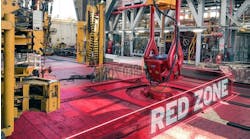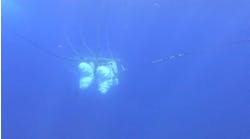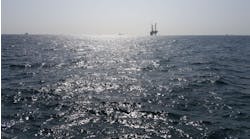Deepwater drilling poses significant additional challenges to the operator. Drilling fluid for a deepwater operation should have rheological properties that provide optimum hole cleaning along with minimum equivalent circulating density (ECD) and minimal tendencies for gelation at cold mud-line temperatures. The ideal fluid should ensure stable borehole conditions for extended periods, possess excellent lubricity, and provide protection against gas hydrate formation. Highly inhibitive fluids with low dilution and consumption rates are of considerable benefit in minimizing logistics and supply problems.
Cooling effect
The low fracture gradient of the formations in many deepwater basins can place severe limitations on mud weight and ECD. The impact of cold temperature on the drilling fluid in the riser tends to make operating in this narrow mud weight/fracture gradient window worse. In ultra-deepwater, the water column can represent up to 50% to 60% of the final well depth and has a major impact on drilling fluid temperature, especially when the drilling fluid remains static for an extended period. Without circulation, the temperature of the fluid in the blowout preventer (BOP) stack and lower riser can reduce to the seabed temperature in less than 12 hours.
The cooling effect of the water column results in markedly increased drilling fluid rheology, which in turn tends to increase drilling fluid ECD. Under static conditions, significant gelation can occur in an invert emulsion fluid, and the pressure required to break this gel structure, to re-establish circulation, can be high.
Data from downhole pressure-measurement tools demonstrates the high-pressure transients that can be impressed upon the borehole when the mud pumps are turned on or off. These pressure fluctuations can easily span approximately 1 ppg during connections and exceed the fracture gradient in a deepwater well if precautions are not taken. High gels also can cause problems of excessive swab and surge and, during a test phase, can hinder the transfer of pressure required to operate downhole test tools.
The effect of the reduced temperature on the fluid in the kill and choke (K&C) lines in deepwater is a particular concern, and substantial mud loss during the pump start-up phase of well kill operations characterizes well-control events in deepwater.
Managing the effect of temperature and pressure on the rheology of a drilling fluid can be crucial to drilling and completing deepwater wells.
Synthetic base mud
These issues have prompted the design of products and systems specifically for deepwater drilling. However, higher performance was required to help cut the high cost of synthetic base mud losses in deepwater drilling operations. One solution in the GoM is the Accolade synthetic invert emulsion drilling fluid, which demonstrates reduced low-temperature gelation effects. The elimination of oregano-clays or organolignites in the fluid’s composition, a first for the industry, results in significantly reduced ECD compared with conventional synthetic base drilling fluids. Gel strengths are fragile and easy to break with substantially lower pressure spikes recorded by downhole pressure-while-drilling measurements, both on breaking circulation and from swab and surge during pipe movements in and out of the borehole.
The synthetic base drilling fluid was originally introduced to comply with US Environmental Protection Agency regulations in the GoM governing discharge of cuttings drilled with synthetic base mud (SBM) and to provide benefits in both shallow and deepwater drilling environments.
A scanning electron microscope (SEM) photograph of the filter cake, on a 35 micron disk, indicates no evidence of mud penetration into the PPA disk.
Originally based on a blend of vegetable ester and internal olefin-base fluids, further development now allows the system to be formulated with alternative synthetic base fluids. The system can meet and exceed the expectations of an oil or synthetic base drilling fluid, including excellent shale inhibition, high drilling rate, and hole cleaning. The high, but fragile, gel strengths can assure good cuttings suspension without incurring barite sag. Flatter, stable rheology is obtained from 40° F to over 350° F at mud densities to 17 ppg. The viscosifier and filtrate loss agents designed for this system work far more quickly than conventional additives and there is no waiting for multiple circulations before mud properties come into line with requirements.
Rheology control
Rheology control of the system is accomplished through the use of custom emulsifiers and surfactants. This is a major step change from the commonly used organophilic clays. By controlling interaction between the oil, water, and solids that make up the fluid, a true gel structure is created similar to that of a water-based fluid. This structure is augmented by use of a swelling polymer and the combination results in the new fluid’s ability to eliminate sag without the use of organo-philic clays. The viscoelastic property of this structure and the fact that it is disrupted relatively easily provides the lower ECD and surge and swab pressures.
The new system resists contaminants, including salt-water flows. No treatment for carbon dioxide (CO2) contamination is necessary as there is no detrimental effect from CO2on the system. Hydrogen sulphide may be treated out using the usual zinc-based or iron-based scavengers.
As a result of the new formulation, product requirements are minimized, resulting in approximately 40% less material required at the rig for fluid maintenance.
The use of a new polymeric filtration-control agent endows the system with a plugging and sealing ability in low-permeability zonesand microfractures. For higher permeabilitysections, the system is treated with plugging/bridging agents in the normal way without adversely affecting the unique rheology profile of this system.
The permeability plugging apparatus (PPA) run with 5-micron, 35-micron, and 60-micron disks and a 10.2-ppg fluid demonstrates the cake-building characteristics of this system. The base fluid, containing no bridging materials, outperformed all other fluids on the 5-micron and 35-micron disks. Bridging material was only required (at 15-20 ppb) to achieve acceptable PPA results on the 60 micron disk. The fluid was tested at 250° F and 1,500 psi. A scanning electron microscope (SEM) photograph of the filter cake on a 35-micron disk indicates no evidence of mud penetration into the PPA disk.
Conducting return permeability comparison tests between the new system and a standard low toxicity mineral oil based mud using Berea sandstone assessed the formation damage potential. Both were weighted to 10.7 ppg with 70/30 oil water ratios and 275,000-ppm chloride water phase salinity. The tests were conducted using an automated return permeameter at 1,500 psi confining pressure and 200° F. The new SBM gave 97% return permeability compared with 48% from the standard low toxicity oil mud and a cake lift-off pressure of less than 1 psi.
Enhanced hole cleaning
Field usage has demonstrated that the new system can provide enhanced hole cleaning with reduced ECD and no instances of barite sag. Downhole drilling fluid losses while drilling, tripping, running casing, and cementing have been up to 80% lower than on offset wells drilled with conventional SBM. A number of projects have experienced this outcome, resulting in increased efficiency, cost savings, and in some cases, extended casing points. The system drilled depleted zones and known loss zones with minimal losses by pretreating the system with bridging agents and lost-circulation material.
An indication of the stability of the system was provided in the first field trial when two salt-water flows occurred shortly after displacing to the new system. The resulting impact on the fluid was minimal with no significant change in viscosity. Similarly, mud weight increases following several gas influxes were tolerated effortlessly. Careful monitoring of mud weight and pressure-while-drilling data has given no indication of any barite sag in any of the wells to date.
On one recent deepwater well, the operator expected downhole mud to be over 9,400 bbl, based on offset well experience. As a result of the reduced ECD and careful fluids management, the actual mud losses were around 2,600 bbl, representing a saving of over $1,350,000 in mud cost. The overall reduction in well construction cost was estimated to be at least $3,750,000.
The ECD measurement using a downhole pressure while drilling service shows that it is 0.3 ppg lower than that for a conventional synthetic base mud in the same hole section (12 1/4-in.) on an offset well.
On another well, a 14.3-ppg field mud was used to drill 8 1/2-in. hole with 5 7/8-in. drill-pipe to over 24,000 ft in a hole deviated to over 55°. The ECD of this fluid was only 0.1 ppg higher than that experienced on the offset wells drilled using 5-in. drillpipe.
On six offset wells, an average of 1,750 bbl of mud was lost per well. With the new system, losses fell to 250 bbl per well, an immediate saving of some $250,000 per well in direct mud cost alone.
Another operator, a major independent, has used the new system on numerous wells in the GoM. The drilling manager stated that the new system’s unique performance has saved him a minimum of $500,000 per well in reduced mud losses and saved rig time.
Water-based fluid
One of the challenges of using oil-based and synthetic base drilling fluids has been the increasing level of environmental concern and legislation associated with their use. These challenges have driven the search for a high-performance water-based drilling fluid (HPWBDF) that will provide oil-based drilling fluid performance and be environmentally acceptable in all offshore areas of the world.
The Hydro-Guard 2 system has performed in the highly reactive, gumbo-making shales of the GoM. Based on a modified poly-acrylamide chemistry, this system has none of the drawback of PHPA systems and has demonstrated an ability to deliver the excellent hole conditions, cuttings integrity, and drilling rates normally associated with synthetic-base mud. The system meets and exceeds all EPA standards for discharge of water-based fluids using the recommended product mix.
The inhibitive water-based fluid is formulated with soluble salts and/or glycol to inhibit hydrate formation. The system is clay-free and exhibits stable yield point and gel strength values from 40° to 300° F. The polymer chemistry that controls rheological properties provide shear-thinning at the bit for fast drilling, yet can ensure the efficient capture and removal of drill solids. The wellbore remains stable and in-gauge, reducing the need for frequent wiper trips. Typical formulations exhibit low friction coefficients for minimal torque and drag and high return permeability.
Shale hydration, minimized
Two proprietary polymeric additives help minimize shale hydration almost instantaneously. One polymer is a potent flocculent that is effective at low concentrations, allowing the encapsulation of drill solids as they are produced at the bit. The second polymer helps prevent hydration and disintegration of clay-rich formations, especially in troublesome gumbo-type formations found in deepwater drilling.
In some areas of the GoM, when drilling with conventional water-based fluids, gumbo boxes must be cleaned every few hours as they become plugged with large, sticky lumps of clay. The system coats the highly reactive clays, preventing them from adhering together, so the clay is easily removed from the system in baseball-sized and smaller pieces. Field results show this drilling fluid reduces bit and BHA balling, a problem that can seriously affects drilling rate. The bit and bottom-hole assembly (BHA) emerge from the wellbore with minimal solids build-up, significantly decreasing the need to spend expensive rig time removing accretion from the BHA and bit.
The system additives mix into the base fluid rapidly, without the viscosity hump that can occur with other polymer systems. Should cuttings begin to show slight degradation, additions of flocculent and inhibitor can correct the problem in one circulation. Fluid loss control is managed with proven, effective starch-based additives. No commercial clay additions are necessary. The system is well-suited for rigs with limited deck space, or those operations where synthetic base fluid drill cuttings are not currently permitted for discharge.
System effectiveness
On one deepwater well, the system drilled over 4,000 ft of 17-in. hole and over 3,000 ft of 12 1/4-in. hole. No wiper trips were required and, at the end of the interval, the methylene blue test (MBT) result (the standard measure of clay content) was low at 7.5 ppb, compared with 25 to 30 ppb for a typical PHPA polymer fluid under equivalent drilling conditions. Drilled solids were flocculated, encapsulated, and easily removed from the system with conventional solids control equipment. At the shakers, the cuttings appeared crisp and glossy, indicating excellent inhibition.
For optimum performance, the system is run with 15 to 24% sodium chloride or combined sodium and potassium chloride salts. The fluid can be weighted up to 17 ppg and has the potential to be recycled. Tests using Berea sandstone show that the drilling fluid leaves a very thin, slick filter cake with minimal formation penetration and very low lift-off pressures. The low dilution and mud consumption rates make the system especially well-suited for rigs with limited deck space or remote operations.
Field experience has shown that the system can be effective from below the 20-in. casing to total well depth. The system has less colloidal content than invert systems, enabling enhanced penetration rates of 100 ft/hr or more and a lower ECD than conventional water-based or synthetic base drilling fluids.
The system has demonstrated excellent suspension and hole cleaning properties, while remaining shear sensitive, and is highly resistant to contamination. In reservoir sections, minimal invasion and superior return permeability have been observed. Gelation tendencies at low temperature are minimal, compared with a conventional synthetic base mud. The low ECD has assisted operators in dealing with a narrow mud weight/fracture gradient drilling window, with substantially reduced risk of severe losses.
The drilling performance of the water-based drilling fluid system approaches and closely replicates that expected from a synthetic or oil-based fluid, with all drilling targets achieved or exceeded. Stable hole conditions can be achieved with no bitballing or sticking tendencies downhole. Good hole cleaning can be achieved along with excellent cuttings separation at the shakers. Low fluid dilution and consumption rates help ensure reduced levels of drilling fluid discharge and environmental impact. This system is also clay-free and of low colloidal content, endowing it with lower ECD than alternative systems and making it ideal for deepwater drilling.
Editor’s note: This article, a summary of Deepwater drilling fluids - What’s new, was presented at the 2004 DOT Conference.






